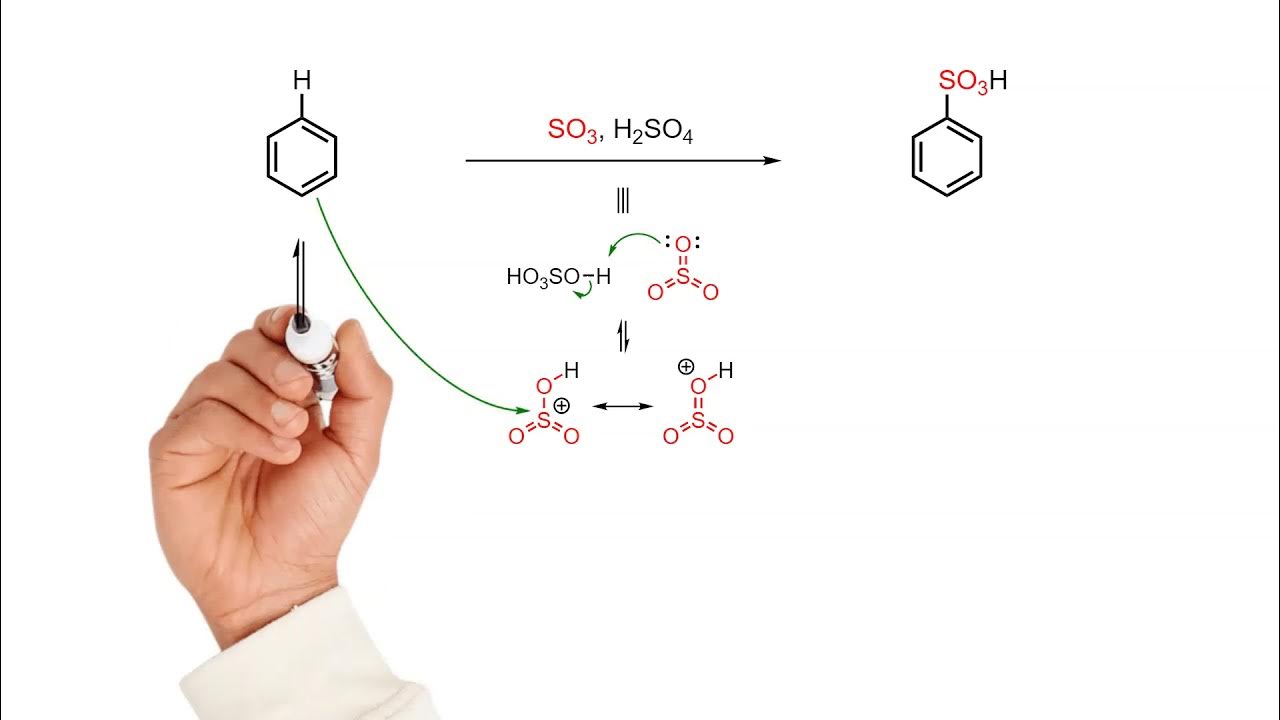Reaksi Benzena | Reaksi Alkilasi Friedel-Crafts: Mekanisme Reaksi dan Batasan Alkilasi [LENGKAP]
Summary
TLDRThis video explains the Friedel-Crafts alkylation reaction, a method for adding alkyl groups to aromatic rings like benzene. The reaction involves using an alkyl halide and a Lewis acid catalyst to form a carbocation, which then attacks the aromatic ring. The video details the reaction mechanism, the role of catalysts, and common limitations such as polyalkylation, carbocation rearrangement, and the influence of electron-withdrawing groups. It also discusses applications of the reaction in organic chemistry, including the synthesis of complex natural products and industrial chemicals, making it a vital reaction for both research and industry.
Takeaways
- 😀 Friedel-Crafts alkylation is a reaction that adds alkyl groups to aromatic rings through the formation of carbon-carbon bonds.
- 😀 This reaction is named after chemists Charles Friedel and James Crafts, who developed it in 1877.
- 😀 The reaction requires a catalyst, typically a Lewis acid like AlCl3, to facilitate the substitution of a hydrogen atom on the aromatic ring with an alkyl group.
- 😀 The Friedel-Crafts alkylation reaction is a thermodynamically controlled process that results in the formation of a stable product.
- 😀 The reaction proceeds through three stages: carbocation formation, electrophilic attack on the aromatic ring, and proton release to yield the alkylated product.
- 😀 The Lewis acid catalyst, such as AlCl3, enhances the reactivity of alkyl halides and facilitates the reaction by generating a stable carbocation electrophile.
- 😀 Friedel-Crafts alkylation is not effective with aryl halides and vinyl halides due to the instability of the carbocations they produce.
- 😀 One limitation of the reaction is polyalkylation, where multiple alkyl groups can be attached to the aromatic ring, leading to a mixture of products.
- 😀 Carbocation rearrangement can occur in the reaction, especially with primary alkyl halides, producing products that differ from the expected ones.
- 😀 The reaction works best with electron-rich aromatic rings, while aromatic rings with electron-withdrawing groups (like benzaldehyde) do not react effectively.
- 😀 Friedel-Crafts alkylation is widely applied in organic chemistry for the synthesis of complex natural products and molecules, although it has practical limitations compared to acylation reactions.
Q & A
What is the Friedel-Crafts alkylation reaction?
-The Friedel-Crafts alkylation is a substitution reaction that involves the replacement of a hydrogen atom in an aromatic ring with an alkyl group. It is used to form carbon-carbon bonds involving aromatic rings like benzene.
Who discovered the Friedel-Crafts alkylation reaction?
-The Friedel-Crafts alkylation reaction was discovered by chemists Charles Friedel and James Crafts in 1877.
What are the two main types of Friedel-Crafts reactions?
-The two main types of Friedel-Crafts reactions are alkylation and acylation. This video focuses specifically on the Friedel-Crafts alkylation reaction.
What is the role of a Lewis acid catalyst in the Friedel-Crafts alkylation reaction?
-The Lewis acid catalyst, such as aluminum chloride (AlCl3) or iron chloride (FeCl3), is crucial for generating a stable carbocation, which acts as the electrophile that attacks the aromatic ring in the alkylation reaction.
How is the carbocation formed in the Friedel-Crafts alkylation mechanism?
-The carbocation is formed when an alkyl halide reacts with a Lewis acid catalyst like AlCl3, creating a carbocation that is highly electrophilic and ready to react with the benzene ring.
What are the three main stages of the Friedel-Crafts alkylation mechanism?
-The three stages are: 1) Formation of a carbocation (the electrophile), 2) Electrophilic attack by the carbocation on the benzene ring to form a sigma complex, and 3) Proton release to form the alkylated product and regenerate the catalyst.
Why is the Friedel-Crafts alkylation reaction considered thermodynamically controlled?
-The reaction is thermodynamically controlled because it leads to the formation of a more stable product, especially when rearrangements of carbocations occur to form more stable structures.
What are some limitations of the Friedel-Crafts alkylation reaction?
-Some limitations include: 1) It cannot be used with aryl or vinyl halides, 2) It can lead to polyalkylation, 3) Carbocation rearrangement can produce unexpected products, 4) It does not work well with electron-withdrawing groups, and 5) It can be ineffective with strongly activated aromatic compounds like phenol.
Can the Friedel-Crafts alkylation reaction occur without a catalyst?
-Technically, the reaction can occur without a Lewis acid catalyst, but it would be slower, less efficient, and produce fewer desired products.
What are the applications of the Friedel-Crafts alkylation reaction in organic chemistry?
-The Friedel-Crafts alkylation reaction is widely used in organic chemistry, particularly in the synthesis of natural products and complex molecules. It plays a key role in the formation of alkylated aromatic compounds, which are important in various industrial and research applications.
Outlines

此内容仅限付费用户访问。 请升级后访问。
立即升级Mindmap

此内容仅限付费用户访问。 请升级后访问。
立即升级Keywords

此内容仅限付费用户访问。 请升级后访问。
立即升级Highlights

此内容仅限付费用户访问。 请升级后访问。
立即升级Transcripts

此内容仅限付费用户访问。 请升级后访问。
立即升级5.0 / 5 (0 votes)






